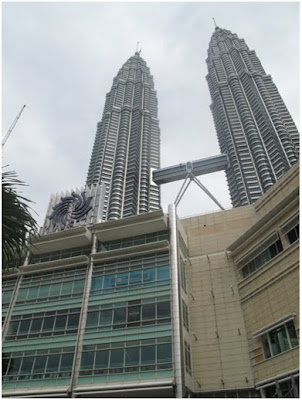1.Embrace of the future
Description: The 88-storey PETRONAS Twin Towers is located at the North-west corner of the 100-acre development, the Towers standing majestically at 452metres have been acknowledged by the Council on Tall Buildings and Urban Habitat as the tallest buildings in the world. The exterior of the PETRONAS Twin Towers is organized in horizontal ribbons of vision glass and stainless steel which glint and shimmer in the sun.
Explanation: The 452 meter PETRONAS Twin Towers, when seen from above, resembles the Islamic geometric motifs. While looking from street level, the all-glass shell of the building gives a post-modern take on the more traditional motif. The Kuala Lumpur Convention Centre, next door to the towers follows the same theme. The convention center will have the shape of an eagle if viewed from above, while the all-glass shell of the building gives a more post-modern look.
2. Freezing of the Past
Description: FTMS international campuses, located in dynamic city centre. The exterior look of this building is remain the vernacular shophouse architectural style. Internal courtyards and ventilation shafts in the rear of the shophouse allow light and air to penetrate so that the structure does not become oppressive or stuffy, while shutters can be used to protect the windows during heavy weather and to control the flow of air through the shophouse.
Explanation: In comparison to traditional shophouses, modern variations through the 1960s to 1980s were devoid of ornamental decorations and are more often designed for utilitarian purposes. Beginning the 1990s, the buildings began to adopt postmodern and revival styles. Traditional shophouse facade ornamentation draws inspiration from the Malay, Chinese and European traditions.
3.Transition between the Past and the Present
Description: The facade of the Dayabumi tower is adorned with patterns of eight-pointed stars, and Islamic arches at the top and bottom of the tower.
Explanation: The passive design features on the surface of Dayabumi and the Post Office Headquarter have the ability to control and channel natural sunlight as well as ventilation that offers pleasant ambient into the internal spaces. This feature is still remained from the past.
4.Cultural Crossroads
Description: At the end of Petaling Street, you can further explore the Chan See Shu Yuen Temple which dates back to 1906. The interior of this building features open courtyard pavilions, intricate carvings and paintings. On the exterior, the temple depicts elaborate glazed ceramic sculptures which grace the facade and roof ridges. the Sri Mahamariamman Temple is the oldest and richest Hindu temple in Kuala Lumpur. It is situated at edge of Chinatown In 1968, a new structure was built, featuring the ornate 'Raja Gopuram' tower in the style of South Indian temples. From its inception, the temple provided an important place of worship for early Indian immigrants and is now an important cultural and national heritage.
Explanation: There are two different culture exist in the Petaling Street area. The two different culture are Chinese culture and Indian culture which carry by the Chinese and Hindu temple. This shows the cultural crossroad obviously.
5. Collapsing Identity
Description: There are shophouses and modern buildings founded along the petaling street. Shophouse is a vernacular architectural building type. This hybrid building form characterises the historical centres of most towns and cities in the region.
Explanation: The shophouse is form by simple geometric shape and it is symmetrical. While the modern building beside there with modern materials such as concrete, glass and steel are used. There is no ornamentation on the facade and the windows are of ribbon windows. This makes a effect of collapsing of identity of the building area.





No comments:
Post a Comment